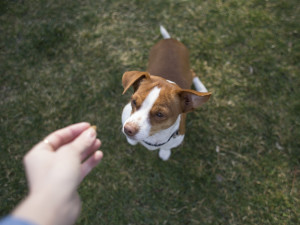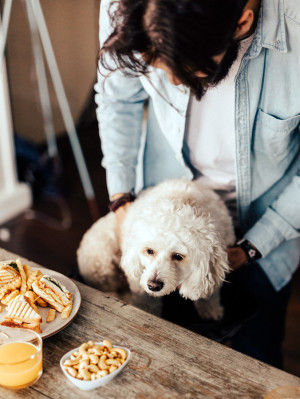Can Dogs Eat Pistachios? Find Out if They Are Toxic
It’s not exactly an easy answer.

Share Article
The first humans to eat pistachios may have wondered if they were OK to eat since they have a hard shell. Curiosity and hunger must have convinced them to give in, because now pistachios are a popular snack for humans, packed with flavor and nutrients.
While your dog might eagerly wag their tail at the thought of joining your nutty feast, it’s worth considering whether pistachios are a treat or a trap. The truth is it’s not an easy question to answer. While pistachios aren’t inherently toxic to dogs, they’re not the ideal treat, either. Let’s find out why.
Nutritional content of pistachios
Despite their small size, pistachios are big when it comes to nutrition. They are rich in many nutrients. Here are a few of their benefits:
For heart health and a source of energy, the healthy fats in pistachios are hard to beat.
They are a good source of protein, which is necessary for the maintenance and growth of muscle.
Vitamin B6 supports brain development and immune function.
Magnesium is instrumental for bone health and energy production.
As a source of antioxidants, pistachios help fight oxidative stress.
However, both people and dogs need to avoid eating too many due to the high calorie and fat content of pistachios.

Can dogs eat pistachios?
We still haven’t quite answered the question. It’s important to weigh the pros and cons. Here’s a little more information.
Benefits of feeding your dog pistachios
The nutrients mentioned can definitely provide some health benefits when fed to your dog. Let’s break that down further.
Pistachios offer protein and vitamins that support overall health.
Antioxidants, more specifically, can decrease inflammation and provide support to the immune system.
Healthy fats make your dog’s coat healthy and shiny. They also are a good source of energy.
Fiber in small amounts may aid in digestion.
While it’s true that pistachios contain these nutrients, these benefits are available in many other foods that are safe for dogs.
Risks of feeding your dog pistachios
While there are indeed benefits to your dog eating pistachios, there are also risks.
If dogs consume too much fat, they risk developing obesity or pancreatitis. Therefore, you should keep your dog’s intake to a small, occasional snack.
Many store-bought pistachios are salted, which can cause sodium poisoning in dogs, leading to excessive thirst, urination, or even kidney damage. Salt toxicity can cause depression, seizures, or even death.
It’s possible to choke on the nut or the hard shells. They can also cause blockages in the intestines.
Pistachios can harbor aflatoxins, a mold toxin that can lead to liver damage.
Just as humans can have allergies, especially allergies to nuts, dogs can also. Watch your dog closely the first time they eat pistachios.
Always evaluate a new food, see if the benefits outweigh the risks, and speak to your vet.
Can dogs eat pistachio ice cream?
Pistachio ice cream is not a safe treat for dogs. Here’s why:
Ice cream has tons of sugar, which is bad for dogs.
Some ice creams have xylitol, an artificial sweetener, to replace so much sugar. Xylitol is toxic for dogs, causing low blood sugar, liver failure, and even death.
Many dogs are lactose intolerant, which tends to cause GI upsets in dogs that eat or drink dairy products.
Artificial flavors and preservatives can be found in many pistachio ice creams, which can harm dogs.
How many pistachios can your dog eat?
If you decide to give your dog pistachios, keep it light. A few unsalted, shelled pistachios can be an occasional treat for most dogs. Here’s a sample chart that will give you an idea of the number of pistachios your dog can have per week.
Small dogs: One to two pistachios.
Medium dogs: three to five pistachios.
Large dogs: five to 10 pistachios.
Don’t overfeed pistachios; your dog can end up vomiting or with diarrhea or abdominal discomfort. Always introduce new foods gradually and monitor your dog for any signs of discomfort or allergic reaction.
Symptoms of pistachio-related illness in dogs
If your dog eats too many pistachios or salted or mold-contaminated nuts, you should watch for the following signs of pistachio poisoning.
Vomiting
Diarrhea
Lethargy
Loss of appetite
Abdominal pain
Tremors (in severe cases)
Increased thirst or urination (due to high sodium intake)
Jaundice (a sign of liver damage from aflatoxins)
If you notice any of these symptoms, contact your veterinarian immediately. Early intervention can prevent serious complications.
Safe alternatives to pistachios for dogs
Rather than take the risks associated with pistachios for dogs, try some of the following fruits and vegetables:
Safe fruits for dogs (in moderation)
Apples: Remove the seeds and core.
Bananas: Serve in small amounts due to sugar content.
Blueberries: Packed with antioxidants and vitamins.
Strawberries: Avoid too much due to natural sugars.
Watermelon: Remove seeds and rind.
Pineapple: Remove the tough skin and core.
Mango: Remove the pit.
Pears: Remove the seeds and core.
Peaches: Remove the pit.
Cantaloupe: Low-calorie and hydrating
Cranberries: Safe in moderation, but avoid cranberry sauces with added sugar.
Safe vegetables for dogs
Carrots: Great for chewing and rich in beta-carotene and fiber.
Green beans: Low-calorie and good for weight management.
Sweet potatoes: Cooked and peeled; a great source of fiber and vitamins.
Pumpkin: Plain, cooked, or canned pumpkin (without spices); helps digestion.
Broccoli: Small amounts; high in fiber and vitamin C (avoid large quantities due to potential gas).
Zucchini: Low-calorie and packed with vitamins.
Cucumber: Hydrating and great for low-calorie snacking.
Spinach: Should be given in small amounts because this food is high in oxalates.
Peas: Plain green peas, sugar snap peas, or snow peas are safe and nutritious.
Celery: Freshens breath and is a low-calorie treat.
Bell peppers: All colors are fine, but red peppers are the most nutritious.
Moderation is key; fruits contain a lot of sugar, which can cause issues if you feed them to your pup as more than an occasional snack. Always wash, peel, and remove seeds, pits, or cores that may be toxic or pose a choking hazard. Avoid seasonings: serve fruits and veggies plain, without added salt, butter, or spices.
Bottom line
While dogs can eat a few pistachios, there are safer things for them to consume. Pistachios aren’t toxic, but they have risks. If you decide to share a few with your dog, be sure to only give a small number of unsalted and shelled pistachios. There are safer alternatives for treats for your dog. Vegetables and fruits that are dog-safe are a good example. It’s a good idea to always talk to your vet before giving them a new food.
References
“Aflatoxin in Pistachios: What You Should Know.” Healwithfood.org, 2025, www.healwithfood.org/aflatoxin/pistachios-among-most-contaminated-nuts#google_vignetteopens in new tab. Accessed 17 Feb. 2025.
Bichelman, Jamie. “Why Vets Say Pistachios Are a Snack to Avoid for Your Canine.” MSN. January 14, 2025. https://www.msn.com/en-us/food-and-drink/general/why-vets-say-pistachios-are-a-snack-to-avoid-for-your-canine/ar-BB1rrHca?ocid=BingNewsSerpopens in new tab. Accessed 17 Feb. 2025.
Patterdale, Sassafras. “Can Dogs Eat Pistachios?” American Kennel Club, 8 Dec. 2022, www.akc.org/expert-advice/nutrition/can-dogs-eat-pistachios/opens in new tab. Accessed 17 Feb. 2025.

Dr. Shelby Neely, DVM
Dr. Shelby Neely is a freelance writer and veterinarian who graduated from the University of Pennsylvania School of Veterinary Medicine and has practiced veterinary medicine for 30 years, specializing in small animals. Her work has appeared in Allivet, AsktheCatDoctor, WhiskerDocs, Ask the Cat Doctor Radio, Ask the Cat Doctor TV, and numerous other websites, brochures, newsletters, newspapers, and ebooks. In her spare time, Dr. Neely likes to spend time with her three children, two grandchildren, three cats, two grand-cats, and five grand-dogs.
Related articles
Can Dogs Eat Ice Cream?
Summer is here, after all.
![A dog taking a bite of a treat next to a decorated Christmas tree.]()
8 Pet Hazards That May Be in Your Home This Holiday Season
Some plants are not so merry.
Can Dogs Eat Pumpkin?
The superfood is delicious, and it’s a natural remedy for some common pup ailments.
Can Dogs Eat Cinnamon?
Just a sprinkle. Is that OK?
![dog hiding under christmas dinner table eating scraps]()
Which Christmas Foods Can My Dog Eat?
From turkey to stuffing, find out which festive foods it’s safe to sneak your pup from the table.
Can Dogs Eat Cashews?
They’re not toxic, but you don’t wanna overdo it.








